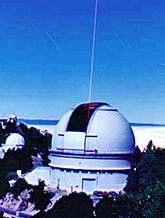Shane Telescope Remote Observing
Lick Links

Changing Scheduled time on Shane
Shane Remote Observing Policy
Call for Small Telescope Proposals
Nickel Remote Observing Policy
Nickel Remote Observing Procedure
Undergraduate Observing Policy
Shane Remote Observing Policy
A. Only observers with experience observing locally with Kast on the Shane telescope, PFCam, AO-NGS and the Hamilton are eligible to observe remotely. Observers must have been checked out, on site, by a Lick support astronomer, and sufficient experience must have been gained.
B. Potential remote users must receive an additional remote-observing checkout.
C. Proposals for remote observing must specify the facility from which the observer will be working. In all other ways, the remote observing proposal process is the same as for local observing.
D. The Lick remote observing system is set up to be run from Keck mainland remote observing facilities at the following sites: UCB, LBNL, UCLA, UCSC, UCSB, UCSD, UCR, UCD, and UCI. Keck observing has priority over Lick observing in these rooms. The observer must coordinate the use of these rooms with the local scheduler.
E. IMPORTANT: Shane remote observers MUST check-in with the telescope technician or support astronomer at the Shane Telescope control room each and every afternoon of their run to obtain clearance to operate the instrument remotely. Remote observers are not permitted to remotely operate the instrument unless and until it has been explicitly released to them by the TT or support astronomer at the Shane Telescope control room.
F. NOTE: Shane remote observers need to maintain a open videoconferencing (Polycom) connection between their remote observing room and the Shane Telescope control room at all times when they operating an instrument on the Shane Telescope remotely.